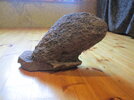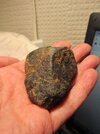This is an article across multiple picture slides that don't add anything to the story. I wasn't able to get the bold out of the quote.
The article stands out to me because it's on a mainstream news site and talks about two minerals that apparently don't exist in nature but were created here on Earth, and now they've been found in a meteorite. So the implication is extra-terrestrial technology.
The article stands out to me because it's on a mainstream news site and talks about two minerals that apparently don't exist in nature but were created here on Earth, and now they've been found in a meteorite. So the implication is extra-terrestrial technology.
Scientists have synthesised two minerals that do not exist in nature: eidite and bresinaite, which can only be created in the laboratory
This statement comes from a team of Venezuelan researchers and scientists who were trying to discover the two minerals in 1975. According to a new study, these materials arrived on Earth
Heidite and Brezianite were created in a US laboratory, but a few years later were found on Earth among meteorite fragments
Now the theory is being put forward that this debris was actually the debris of an alien spaceship left by someone in space
The words of Central University of Venezuela physicist B.P. Embidom
"It is important to be open-minded and even provocative to consider the following question: are these meteorite minerals examples of extraterrestrial technology?"
"The origin of these meteorite minerals may require a controlled and complex process that is not easily found in nature. If after many attempts this hypothesis is not confirmed, then we can begin to question the possibility that these minerals were obtained by industrial processes. In other words, that they are technological signals"
The claim of UFO author Anna Whitty, who told the Daily Star that aliens actually already live on our planet, excluding the underwater world, is different
"I really think they have always been here. If the aliens came from somewhere in the depths of the sea or caves, and not from another planet, it is because there is a lot of evidence on the planet that huge cataclysms occur every few thousand years."



 :
:

